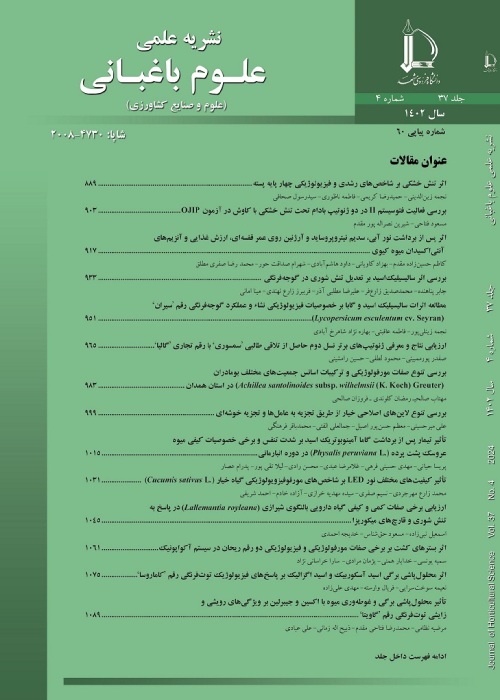Evaluating of Azealic Acid on Tomato Vegetative and Photosynthetic Parameters under Salinity Stress
Author(s):
Article Type:
Research/Original Article (دارای رتبه معتبر)
Abstract:
Introduction
Soil salinity is a global problem that affects approx. 20 % of irrigated land and reduces crop yields significantly. Since, salinity is one of the most important abiotic stress and limiting factor for plant growth all around the world. It is necessary to find some way to ameliorate these damages. The physiological responses of a plant to salinity are often complex and multi-faceted, which makes experiments difficult to design and interpret. At basic level, the response of plants to salinity can be described in two main phases: the shoot ion-independent response occurs first, within minutes to days, and is thought to be related to Na+sensing and signaling. Tomato is one the most popular crop in open door and greenhouse cultivation which could face with salinity stresses. Salinity with inducing osmotic stress could have irreversible damages on plant growth and function. Three main salinity tolerance mechanisms have been proposed: on exclusion – the net exclusion of toxic ions from the shoot; tissue tolerance – the compartmentalization of toxic ions into specific tissues, cells and subcellular organelles; and shoot ion-independent tolerance – the maintenance of growth and water uptake independent of the extent of Na+ accumulation in the shoot. In order to face with stresses plant make some internal signals which cause producing different compound and inducing stress resistance. Salicylic acid is one these resistances induced agent. Azealic acid is an organic compound which could increase salicylic acid accumulation in plants.
Materials and Methods
So that, the present experiment was conducted to evaluate the effect of azealic acid and saline irrigation on tomato vegetative and photosynthetic parameters in factorial design based on CRD with three replications. The treatments were salinity level (0, 100, 150 and 200 mM) and azealic acid (0, 8, 10, and 24 mg l-1). The experiment was conducted in pot and in the greenhouse. Gradually in a week salinity treatments applied for plants after that each week once azelaic treatments also applied in each plant. Two weeks later each gas exchange parameters and all parameters needed fresh plant were measured and at the end all parameters with dry matter measured. The photosynthesis traits like transpiration, photosynthesis rate, mesophyll conductance, stomata conductance some stress indices like proline and antioxidant phenol were measured.
Results and Discussion
Results indicated that with increasing salinity level biomass production reduced. It seems that with azealic supplement especially in AZ2 treatment with improving photosynthetic water use efficiency, stomatal and mesophyll conductance has positive effect on photosynthesis. Under low salinity level azealic acid was an effective treatment in photosynthetic parameters although when salinity exceeds more than 100 mM photosynthetic parameters even with azealic acid application reduced. Azealic acid causes a kind of osmotic balance following that the proline content of these treatment reduced. In all salinity levels when azaleic acid applied the phenolic compound increased significantly and the highest was in AZ3. Azaleic acid reduced the Na concentration of leaves it causing the most tolerate reason against salinity when the azaleic acid applied. Although the photosynthetic rate increased with azaleic acid it is not because of chlorophyll content, because the chlorophyll content decreased with azaleic acid. The increase of photosynthesis could be due to decreasing Na concentration of leaves and increasing defense system of plants. Chlorophyll florescence decreased even with azaleic acid in salinity, it means that azaleic acid cannot completely compensate the stress harmful effect. The growth was improved with azaleic acid in salinity; the improvement was greater in root weight compare with shoot weight. Azaleic acid not only prevent decreasing the weight but also improved them in salinity. In defense system of tomato it seems that antioxidant and phenol content were more effective than proline because they are increased with azaleic acid in saline condition effectively compare with proline.
Conclusions
Finally, it seems that until 100mM salinity level azealic acid with maintaining gas exchange capacity in optimum level and inducing osmotic balance could reduce salinity damages. Conclusively, when azaleic acid was applied in 8mg/l that it improved photosynthetic traits like stomata conductance, mesophyll conductance, and photosynthetic water use efficiency compare with control. Azaleic acid can improve the photosynthetic traits when salinity was in low level like 100mM. Proline which is amino acid role as a defense system of plants increased the osmotic adjustment in plant in response to azaleic acidKeywords:
Language:
Persian
Published:
Journal of horticulture science, Volume:32 Issue: 2, 2018
Pages:
287 to 300
magiran.com/p1880399
دانلود و مطالعه متن این مقاله با یکی از روشهای زیر امکان پذیر است:
اشتراک شخصی
با عضویت و پرداخت آنلاین حق اشتراک یکساله به مبلغ 1,390,000ريال میتوانید 70 عنوان مطلب دانلود کنید!
اشتراک سازمانی
به کتابخانه دانشگاه یا محل کار خود پیشنهاد کنید تا اشتراک سازمانی این پایگاه را برای دسترسی نامحدود همه کاربران به متن مطالب تهیه نمایند!
توجه!
- حق عضویت دریافتی صرف حمایت از نشریات عضو و نگهداری، تکمیل و توسعه مگیران میشود.
- پرداخت حق اشتراک و دانلود مقالات اجازه بازنشر آن در سایر رسانههای چاپی و دیجیتال را به کاربر نمیدهد.
In order to view content subscription is required
Personal subscription
Subscribe magiran.com for 70 € euros via PayPal and download 70 articles during a year.
Organization subscription
Please contact us to subscribe your university or library for unlimited access!


